The Intel Core i9-7980XE and Core i9-7960X CPU Review Part 1: Workstation
by Ian Cutress on September 25, 2017 3:01 AM ESTBenchmarking Performance: CPU System Tests
Our first set of tests is our general system tests. These set of tests are meant to emulate more about what people usually do on a system, like opening large files or processing small stacks of data. This is a bit different to our office testing, which uses more industry standard benchmarks, and a few of the benchmarks here are relatively new and different.
All of our benchmark results can also be found in our benchmark engine, Bench.
PDF Opening
First up is a self-penned test using a monstrous PDF we once received in advance of attending an event. While the PDF was only a single page, it had so many high-quality layers embedded it was taking north of 15 seconds to open and to gain control on the mid-range notebook I was using at the time. This put it as a great candidate for our 'let's open an obnoxious PDF' test. Here we use Adobe Reader DC, and disable all the update functionality within. The benchmark sets the screen to 1080p, opens the PDF to in fit-to-screen mode, and measures the time from sending the command to open the PDF until it is fully displayed and the user can take control of the software again. The test is repeated ten times, and the average time taken. Results are in milliseconds.
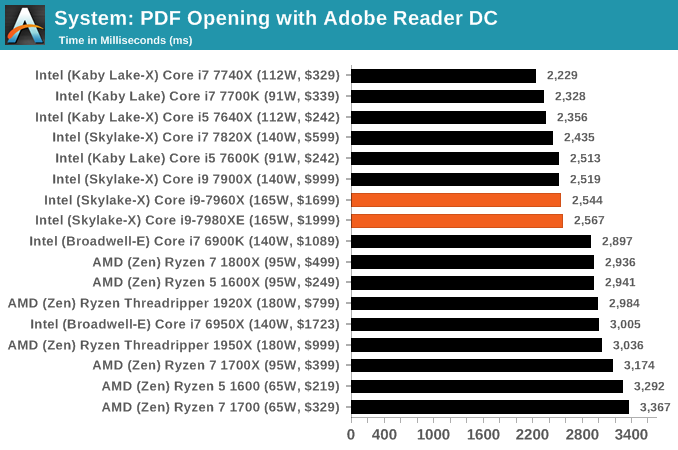
FCAT Processing: link
One of the more interesting workloads that has crossed our desks in recent quarters is FCAT - the tool we use to measure stuttering in gaming due to dropped or runt frames. The FCAT process requires enabling a color-based overlay onto a game, recording the gameplay, and then parsing the video file through the analysis software. The software is mostly single-threaded, however because the video is basically in a raw format, the file size is large and requires moving a lot of data around. For our test, we take a 90-second clip of the Rise of the Tomb Raider benchmark running on a GTX 980 Ti at 1440p, which comes in around 21 GB, and measure the time it takes to process through the visual analysis tool.
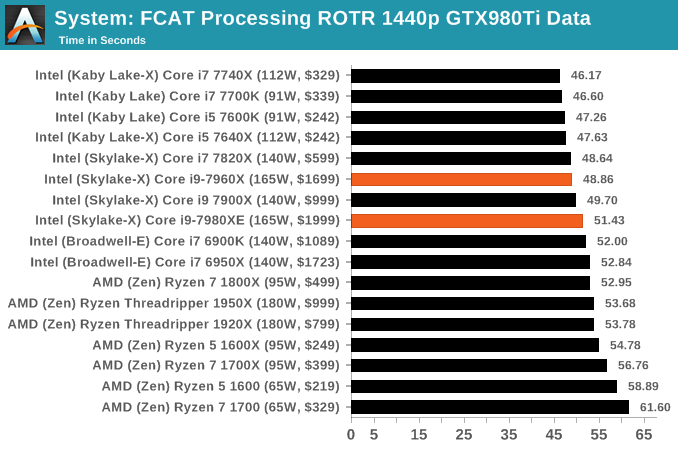
Dolphin Benchmark: link
Many emulators are often bound by single thread CPU performance, and general reports tended to suggest that Haswell provided a significant boost to emulator performance. This benchmark runs a Wii program that ray traces a complex 3D scene inside the Dolphin Wii emulator. Performance on this benchmark is a good proxy of the speed of Dolphin CPU emulation, which is an intensive single core task using most aspects of a CPU. Results are given in minutes, where the Wii itself scores 17.53 minutes.
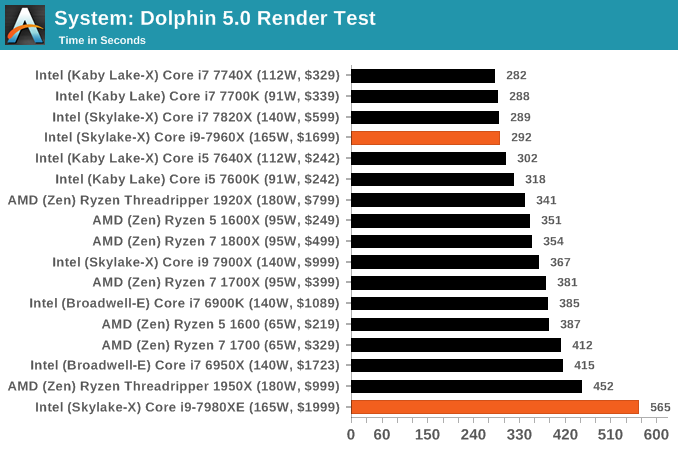
3D Movement Algorithm Test v2.1: link
This is the latest version of the self-penned 3DPM benchmark. The goal of 3DPM is to simulate semi-optimized scientific algorithms taken directly from my doctorate thesis. Version 2.1 improves over 2.0 by passing the main particle structs by reference rather than by value, and decreasing the amount of double->float->double recasts the compiler was adding in. It affords a ~25% speed-up over v2.0, which means new data.
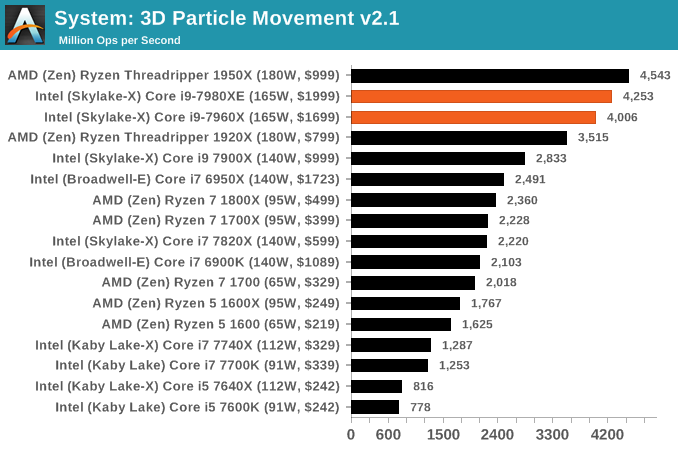
DigiCortex v1.20: link
Despite being a couple of years old, the DigiCortex software is a pet project for the visualization of neuron and synapse activity in the brain. The software comes with a variety of benchmark modes, and we take the small benchmark which runs a 32k neuron/1.8B synapse simulation. The results on the output are given as a fraction of whether the system can simulate in real-time, so anything above a value of one is suitable for real-time work. The benchmark offers a 'no firing synapse' mode, which in essence detects DRAM and bus speed, however we take the firing mode which adds CPU work with every firing.
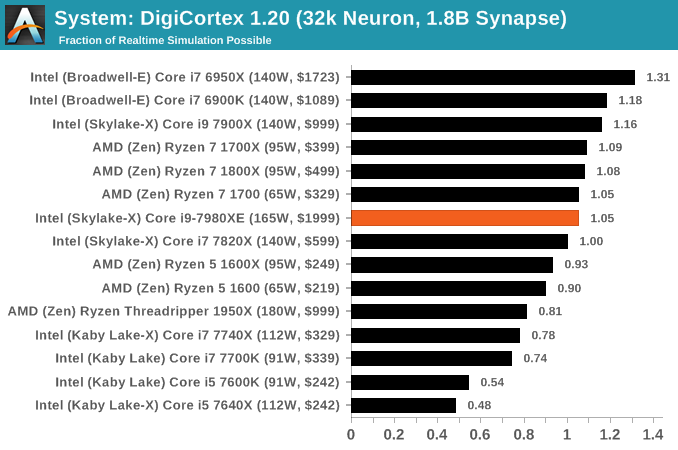
Agisoft Photoscan 1.3.3: link
Photoscan stays in our benchmark suite from the previous version, however now we are running on Windows 10 so features such as Speed Shift on the latest processors come into play. The concept of Photoscan is translating many 2D images into a 3D model - so the more detailed the images, and the more you have, the better the model. The algorithm has four stages, some single threaded and some multi-threaded, along with some cache/memory dependency in there as well. For some of the more variable threaded workload, features such as Speed Shift and XFR will be able to take advantage of CPU stalls or downtime, giving sizeable speedups on newer microarchitectures.
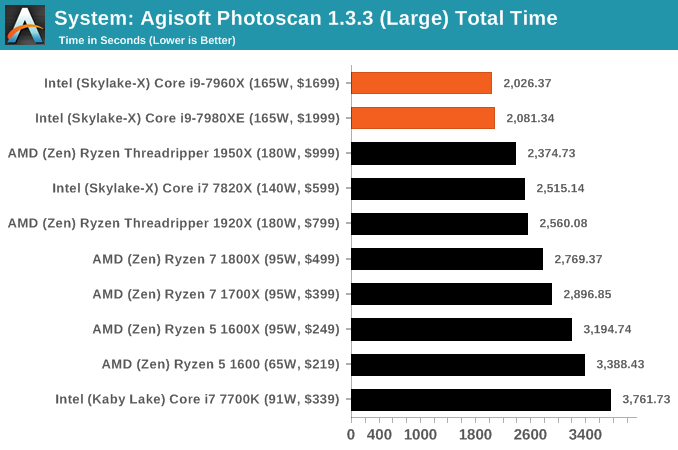










152 Comments
View All Comments
ddriver - Monday, September 25, 2017 - link
Don't worry, they get plenty of support from the big boys for all those shamelessly biassed reviews. And don't act like your pennies will go to feed someone's starving children. So yeah, uBlock FTW.pedrostee - Monday, September 25, 2017 - link
just curious but do you have any evidence, even a small bit, to support your claim that “they get plenty of support from the big boys for all those...”i think it is possible, and you seem a man of science - evidence can support any statement no matter how outlandish — so please present such if you would.
thnks
ddriver - Monday, September 25, 2017 - link
Obvious stuff is obvious, as are you ;) Nice try thou. Are you the one who is going to pay for evidence searching investigation? I personally don't feel like obvious things need evidence, but if you do, go ahead and investigate.ddriver - Monday, September 25, 2017 - link
But the ugliest part is intel went cheap even on a 2000$ CPU, taking a literal dump on it by going for the same old lousy TIM implementation.After this reveal from intel, TR looks even better than it did before.
Notmyusualid - Monday, September 25, 2017 - link
@ pedrosteeIt seems you've finally met the 'village idi0t'. He will provide no evidence, as you likely expected, and we have to endure his bizarre views on ever major article.
Reflex - Monday, September 25, 2017 - link
He's 2017's version of LordRaiden from around 2004 in these forums. Knows just enough to sound knowledgeable to those not in the industry, but is incapable of supporting his assertions because he is running on the theory that if he believes it in his mind it must be true.Look up LordRaiden in the AT forums if you want to see when this last happened.
mkaibear - Monday, September 25, 2017 - link
Yeah, it's hilarious. Anyone who's actually in the IT industry knows he's talking out of his lower orifices and it's always funny to watch him huff about like anyone actually takes him seriously.It's like the cat tax. No article is complete without a good laugh at ddriver.
Reflex - Monday, September 25, 2017 - link
It is unfortunate however because he often derails actually interesting conversations.ddriver - Monday, September 25, 2017 - link
Oh wow, the fanclub is sure gradually moving down, and just when it seemed it already hit the bottom. But hey, if pretending that you are not a completely clueless wannabes works for you, by all means, know yourselves out :)ddriver - Monday, September 25, 2017 - link
You know, I complete agree, however you have mistyped "lame suckers" and typed "IT industry" instead.Here is a hint - you cannot take seriously that which you don't have the capacity to understand. Your "best" boils down to clapping and cheering at the mainstream mediocrity to cultivate the illusion that you are smart. And when someone comes along and tears that illusion down, you are sore to realize the reality about you. And you are only left with denial in the form of those pathetically anemic attempts at intimidation through ridicule. But suckers will be suckers, and as suck, always failing to make a valid argument in their favor :)